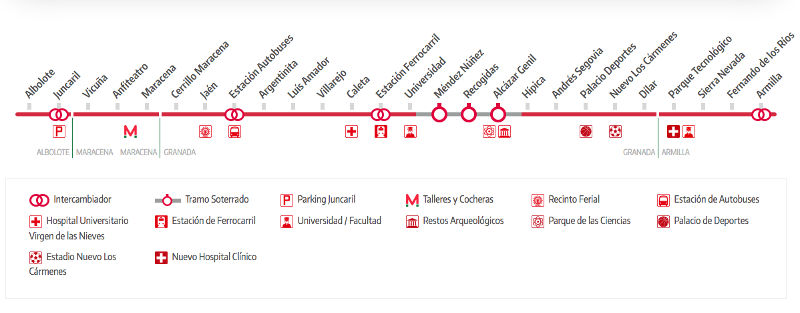The recently inaugurated Granada Metro (09/21/2017,) has a single line and 26 stations. The regular ticket has a price of 1.35 €. During most days, its business hours are from 6:30 am until 11:00 pm, although service is extended for more hours during weekends. The train frequency is of 15 minutes. It is very well connected with the city’s bus system.
Metros in Spain: The Granada Metro (The Granada Metropolitan Light Rail)
Granada is a Spanish city of only 234,000 inhabitants. It is part of the autonomous community of Andalusia, located to the south of the Iberian Peninsula. Although it has a low number of local citizens, Granada is considered an important touristic center in the country thanks to the great cultural patrimony that it hosts.
This city, just like the rest of Spain, experimented an economic boom during the decades of the 60s and the 70s, when the prevailing poverty of the region that was mainly caused by the Civil War started to disappear.
With the so-called Developmentalism, the city’s aspect completely changed, which helped it become a place attractive to tourists.
As a consequence, with the coming of the new Millennium, the authorities took the decision to invest in anything regarding to public transportation, which is vital for the sustainable development of the urban regions.
In 2006, a call for bids was offered to any firm interested in constructing the service known as the Granada Metropolitan. The idea was to build a light rail system with 15 kilometer long path, which would be available to serve downtown Granada.
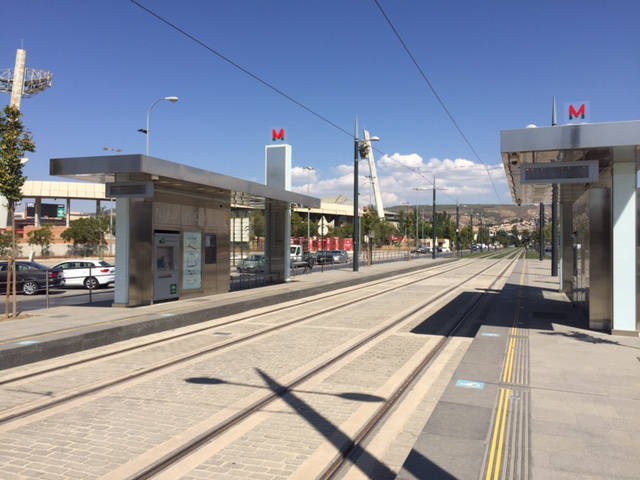
Initially, the planned opening date would be December, 2016, but, for many reasons, this was not the case. Later, the metro system was planned to be officially operational on 2017. The metro finally began service on September 21st, 2017.
Lines and Stations
The Metropolitan Metro of Granada only has one commercial line, comprised of a 15 kilometer long network that serves 26 stations. It is estimated that it transports around 47 thousand people daily. Its tracks are installed throughout the city, starting at the locality of Albolote, and ending at the Armilla municipality. In fact, the light railway service drives through four municipalities in total, which represents a little more than 60% of downtown Granada.
This route was designed to be interconnected with the current bus lines, therefore, both transportation services complement each other. Also, the metro will be linked with the future high speed train station that the city will have, including, of course, the traditional railway terminal.
The stations of the Granada Metropolitan Metro will be shown below:
- Albolote Station: This is one of the two terminal stations of the Granada Metropolitan Metro, located on the municipality of the same name. Within the locality, the stop is located in the Jacobo Camarero Boulevard. Its architecture is comprised of an island platform, in which trains arrive to each side of the platform.
- Juncaril Station: There is no information available about this station.
- Juncaril River Station: There is no information available about this station.
- Vicuña Station: There is no information available about this station.
- Anfiteatro Station: There is no information available about this station.
- Macarena Station: There is no information available about this station.
- Cerrillo de Macarena Station: There is no information available about this station.
- Jaén Station: There is no information available about this station.
- Autobuses Station: The station is located on the Almánjayar neighborhood in the Northern District. It is one of the stops with the biggest dimensions, in part because it connects to the central bus station, where there are medium and long distance routes. It has two floors, one of which works as a waiting room. This floor has a café, as well as a restaurant. This floor is the lower level floor. Meanwhile, on the upper floor, which is elevated, there are vending machines and ticket booths available for the users.
- Argentinita Station: There is no information available about this station.
- Luis Amador Station: There is no information available about this station.
- Villarejo Station: There is no information available about this station.
- Caleta Station: There is no information available about this station.
- Railway Station: This station is currently partially working, since there are construction works under way to prepare the tracks to be utilized for the high speed trains, as well as install new tracks for them. Therefore, the stop is integrated with the Granada Metropolitan Metro service, connecting it to the routes that head towards the different autonomous communities in Spain.
- Universidad Station: There is no information available about this station.
- Méndez Núñez Station: Located on the Ronda District, it is one of the underground stations from the light railway system. It has two floors in which service is offered to the public, and it is comprised of a single platform shaped like an island.
- Recogidas Station: Just like the previous one, it is also located on the Ronda District, and has two levels since it is located underground. It does not have any outstanding features. The lower floor is comprised of an island platform, while the upper floor has customer service booths.
- Alcázar Genil Station: It is an underground station with two floors in the Ronda District. It does not have any outstanding features compared to the rest of the stations.
- Hípica Station: There is no information available about this station.
- Andrés Segovia Station: There is no information available about this station.
- Palacio Deportes Station: There is no information available about this station.
- Nuevo Los Cármenes Station: There is no information available about this station.
- Dílar Station: There is no information available about this station.
- Parque Tecnológico Station: It is located next to the Technological Park of Medical Science of Granada, right in the outskirts of the Armilla municipality, region that inspired the name of the station. It was built with the intention of serving the college students that go every day to campus.
- Sierra Nevada Station: There is no information available about this station.
- Fernando de los Ríos Station: There is no information available about this station.
- Armilla Station: This is the second terminal station of the Metropolitan Metro of Granada. It is located in the region of Armilla, right through a pedestrian zone, and has a single island platform.
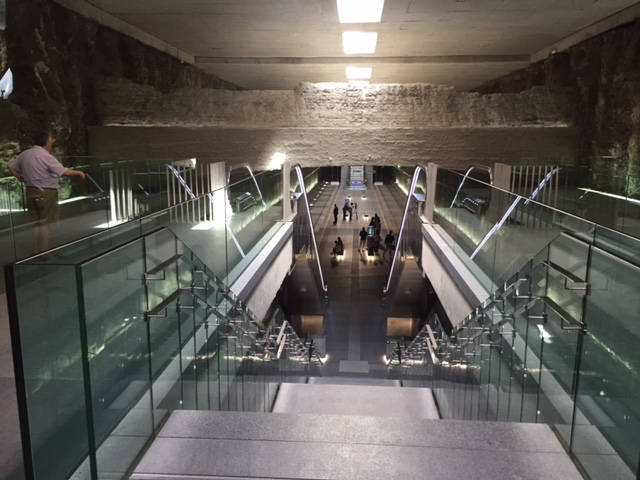
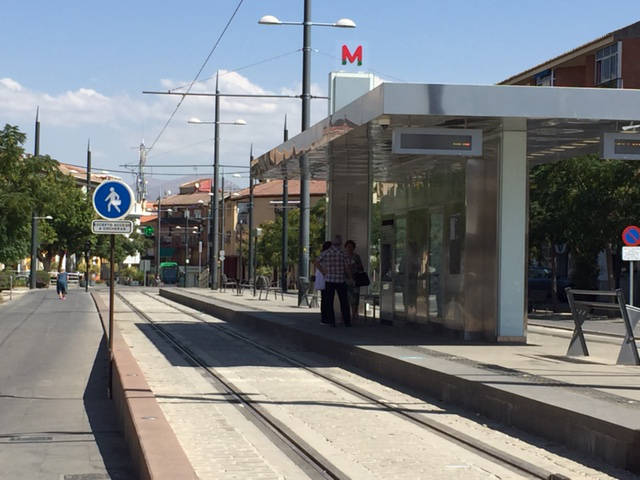
Tickets, Prices, and fares
The Granada Metro has different has different types of fares that are adapted to the user’s needs, including monthly payment subscriptions. The standard fare for one ride among any station within the system has a price of 1.35 €.
Likewise, there are other payment options available, such as cards that work as electronic cash, or tickets for tourists. The different subscriptions and prices available to the passengers of the Granada Metropolitan Metro will be shown below:
- Regular Ticket: It consists in the classic ticket that works to travel among the stations within the metro’s facilities. It costs 1.35 euros for a one-way ride, while the round trip ticket is offered at 2.70 euros. It is only valid for one use, in other words, there is no possibility to renew the same ticket, so you will have to buy a new one. This ticket offers rides to any station for any length of time until you complete your single journey or until the metro ends service.
- Monedero Card: When you use this card, the final price for each trip will be significantly lower than with a regular ticket, charging 0.85 € per ride. However, the card is not free. There are two versions available. On the one hand, there is the cardboard version, which has a price of 0.30 €, and it is valid for a year or until it is deteriorated enough that it will be impossible to use it. On the other hand, there is the plastic version, which has a higher price, costing 1.80 €. Although this card is initially more expensive than the regular tickets, it offers cheaper rides on the long run.
- Touristic Card: It is especially designed for tourists that visit the city. It is comprised of a whole day pass for 4.50 euros, and another one for five days, which has the more expensive price of 13.00 euros. It is important to note that the card can only be used by one person. For instance, if you travel with a group of four people, each person will have to obtain their own card.
- Monthly Subscription: It is a payment option that can be accessed via the Monedero Card. With this subscription, the users can have unlimited rides for 30 days by paying a fixed monthly fee of 40 €. The cards with this subscription can only be used by one passenger at a time.
- Consorcio Card: It is a type of card that is integrated to the metro with the bus routes, although it does not include, up until now, monthly plans for both services. Therefore, the trips will be simply deducted from the cash that the card has loaded in it.
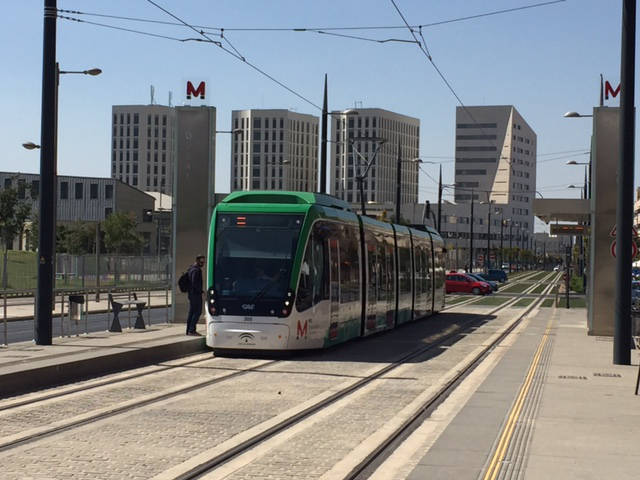
Up until now, there are no known special payment options for people with disabilities or for senior citizens. All of the tickets and cards can be acquired at the public ticket booths available at the different metro stations.
Connections
Many of the Granada Metropolitan Light Rail stations have direct connections to different bus routes that serve the entire city. The description of the system’s stations that have bus stops in their proximity will be shown below:
- Jaén Station: This station is linked to the “Juan Pablo II – Parque de Bomberos” bus stop within a distance of 100 meters, where the bus line number SN2 stops.
- Autobuses Station: This is one of the stations with the highest number of connections to bus routes, since a lot of buses come from the stop “Autobuses Station 1 and 2,” which is within 40 meters from the terminal station. It is interconnected with the lines 121, N4, SN1, SN2, and SN5.
- Argentinita Station: It is interconnected with bus routes number SN2 and N4, which stop at the bus station “Av. Argentinita 7,” located within 10 meters of the station.
- Villarejo Station: The station connects with bus routes number N3, N4, SN2, and SN3 at the stop called “Cruz del Sur,” located within 10 meters of the Light Rail.
- Caleta Station: It is linked with routes N1, N3, and SN4, which serve the “Juzgados” stop at Av. Constitución. This station is located within 100 meters from the Light Rail station.
- Ferrocarril Station: It connects to “Granada Station,” where trains that arrive and depart to different parts of Spain transit, including a high speed train line.
- Méndez Núñez Station: Connects with the bus stop “Camino de Ronda 115” within 70 meters, where bus routes number 111, SN2, and SN3 transit.
- Recogidas Station: This station is linked with the “Camino de Ronda 71” bus stop, where routes number 111, SN2, SN3, SN5, and U3 transit. This stop is located within 90 meters of the Light Rail.
- Alcázar Genil Station: It has a connection with bus routes number 121, SN2, SN5, and U3, which serve the “Camino de Ronda – Alcázar Genil” stop, located within 20 meters of the station.
- Andrés Segovia Station: This station is interconnected with the “Plaza Andrés Segovia – Centro Cívico Zaidin” bus stop, within 30 meters of the Light Rail, where lines 111, S3, and SN2 transit.
- Estadio de los Cármenes Station: The station is located within 80 meters of the “Torre Comares - Rotonda” bus stop, where routes 111 and S3 transit.
- Dílar Station: This station is connected with the “Dílar – Rotonda Av. Los Ilustres” stop, where bus routes number SN4 and U3 transit, within 100 meters of the Light Rail.
- Parque Tecnológico Station: It is only connected with route SN4 at the “Av. Innovación” stop, located at a little over 100 meters of the Light Rail.

Schedule, timetables, and calendar
The Granada Metropolitan Light Rail is available during most of the day, with the purpose of serving the biggest number of users.
From Monday to Thursday, trains are operational at 6:30 am, and work uninterruptedly until 11:00 pm. The trains have a departure frequency of 11 minutes during peak hours, and of 15 minutes during off peak hours.
Meanwhile, during Fridays and Saturdays, as well as holidays, service is extended until 2:00 am, beginning service at 6:30 am on Fridays and at 7:30 am on Saturdays. The departure frequency remains the same during most of the day, until 11:00 at night, where the train frequency changes to 30 minutes, since there are less passengers.
On Sundays, service begins slightly later than usual, starting at 7:30 am, and working until 11:00 pm. The train departure frequency is the same as the rest of the days.
Fun facts
- According to the authorities of the city, the annual transportation demand will someday be of over 10 million users.
- Travelling from one terminal station to the other, or in other words, travelling from one end of the system to the other takes around 45 minutes in total.
- Since the metro is a relatively small means of transportation, which is normal in most light rail services, each train has space for up to 200 passengers.
- The trains in every station wait for 20 seconds so that people can board them.
- The trains drive at an average speed of 20 or 25 km/h.
- The trains have the capacity of driving to a speed of 70 km/h.
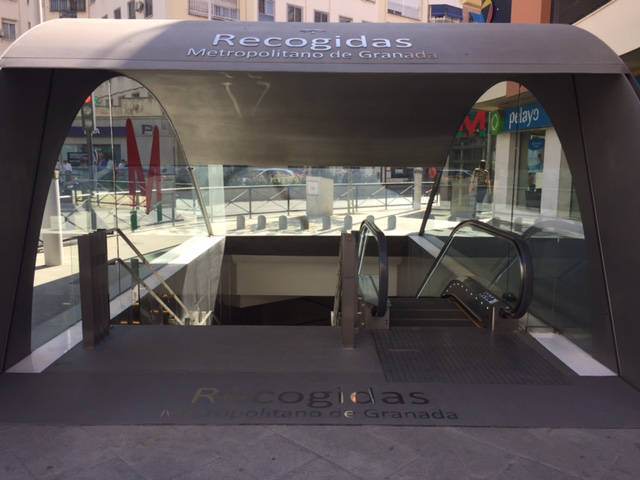
Connection to the airport
The Federico García Lorca Granada-Jaén Airport, with national and international routes, does not have a direct connection to the Granada Metropolitan Metro. However, it is possible to use this service of massive transportation to reach the airport via using a bus line. To do this, the users should follow these instructions:
First, you will have to board the metro towards the Autobuses Station. This is very simple if you follow the system’s instructions. Then, once you reach the aforementioned stop, you should head towards Palacio de Congresos, where there are bus routes that have the airport as a destination.
A distance of 17 kilometers separate the city of Granada and the Federico Garcia Lorca Granada-Jaén Airport. Because of this, the entire journey between Autobuses Station and the airport takes approximately 45 minutes, counting all of the stops. The price for the One Way Ticket has a price of 2.90 euros, which can be paid in cash to the driver or via the Consorcio Card. Likewise, you have the possibility to check the services’ business hours by accessing the airport’s website.
To do this journey on the opposite direction is even easier, that is, from the airport to downtown Granada. Just in front of the main entrance of the airport there is a bus stop where the buses with destination to downtown Granada arrive. To make a connection to the Metropolitan Metro of Granada, you will need to travel in the bus, and then get off at Palacio de Congresos, where the Autobuses metro station is located.
Future expansions
The authorities have informed that there is the possibility that a second line for the metro will be built. The alternative route would be parallel to the main one, complementing the service. The project does not have a starting date nor an ending date. In any case, the managers and investors should wait to get more data from line 1 to calculate the profitability of building a second line.
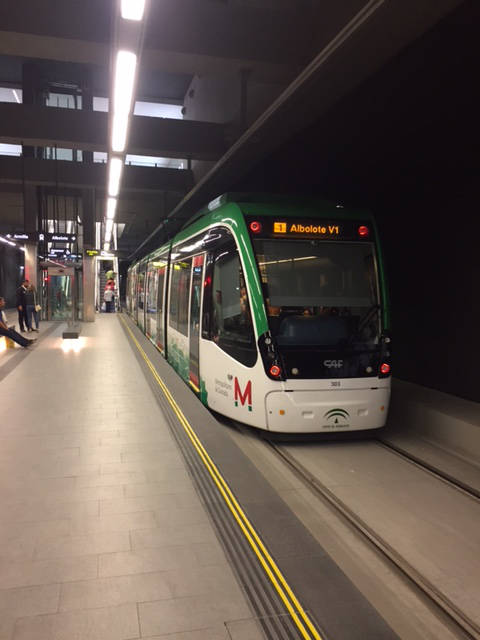
There have been also discussions among many construction companies and the city hall about the possibility of building a line that would join Granada with nearby towns such as Santa Fe, as well as stopping by the airport. However, these plans are currently just speculations.
Nearby Attractions
The touristic attractions that Granada offers are abundant, therefore, it will not be difficult to find what to do near the Light Rail stations. However, there are a few points of interest that should be highlighted.
Firstly, within a few meters of the “Universidad” station, the beautiful San Juan de Dios Basilica is located. It is a magnificent building that dates back to the 18th century, when it was built due to the initiative of the Alonso de Jesús y Ortega priest. It has impressive paintings in its roofs, where some Bible passages are narrated. On the 20th century, this building was officially considered a basilica by Pope Benedict XV. Also, the remains of San Juan de Dios, the patron saint of Granada, lie on this Basilica. He is also known as the Universal Patron Saint of Hospitals. This basilica is without a doubt a patrimony inherent of the city that should be visited by people who visit this locality.
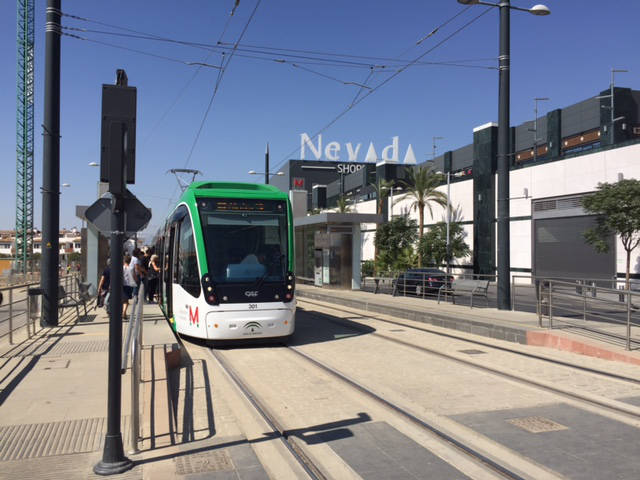
Secondly, the famous Museum of Science of Granada is located near the “Alcázar del Genil” station. It was inaugurated on 1995 and, since then, it has been considered an important touristic place in the city. Its facilities have big spaces for the diverse flora and fauna exhibits that are hosted in the museum, as well as counting with an aquarium. It is an ideal place for the enjoyment of children, and it is also an ideal place to learn about topics such as astronomy and science in general, since this museum has interactive rooms that are conditioned to teach children about such topics.
Granada Metropolitano de Granada map
- Also Known As: Metropolitano de Granada
- Passengers/Day
- Fares: 1,35€
- 24h operation: No
- Air Conditioning: Yes
- Walk between platforms:
- Driverless trains: No
- Screen Doors Platforms:
- Average Speed: 30km/h
- Max. Speed: 70km/h
- Operator: Avanza Metro de Granada
- 1,35€
- Granada Metro Official Website
- Tlf: 958 98 81 23
Help us
If you consider that the information we provide is wrong, not accurated, outdated, translation contains errors, and you would like to help us to improve the file...you can contact us here.
Feel free to contact us if you dont find the system you're looking for and we'll add it as soon as we can!
Thank you very much!





